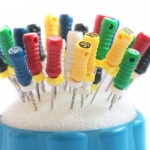
The clinical success of root canal treatment [RoCT] is known to be a function of both mechanical debridement and chemical irrigation. Even as file materials have advanced there has been an acceptance that there are limits to what can be achieved mechanically. Researchers have therefore focused on maximising the effectiveness of the irrigation phase of RoCT. An ideal irrigant would be able to remove debris, provide lubrication, remove the smear layer, dissolve organic and in-organic matter, penetrate canals and have a broad antimicrobial action. As yet, this ideal irrigant does not exist. Using a combination of sodium hypochlorite and the chelating agent ethylenediaminetetraacetic acid (EDTA) provides the dentist with a close approximation to an idealised irrigant. Part of the focus on maximising the irrigation phase has been on various techniques to activate the irrigant within the root canal system.
This new systematic review examined the available evidence on the effectiveness of a variety of activation techniques when compared to conventional needle irrigation.
Methods
- Searches were conducted in: PubMed, EMBASE, Cochrane Library, Science Direct, Web of Science and Google Scholar
- Papers included were scanning electron microscopy studies comparing smear layer and/or debris removal following irrigant activation techniques [IAT] versus conventional needle irrigation [CNI]
- Irrigation techniques were: manual dynamic activation, passive ultrasonic irrigation, sonic irrigation or apical negative pressure
- Teeth included were mature permanent teeth
- Meta-analyses were performed for various canal segments [coronal, middle, apical, apical 1mm]
Results
- 16 papers were included within the review with 12 papers providing sufficient data for inclusion in the meta-analysis
- IAT techniques showed significant improvements in smear layer and debris removal in the coronal, middle and apical thirds of root canals
- In the apical 1mm, there was an improvement in smear layer and debris removal but this was not statistically significant
- Statistically significant results for smear layer removal in the coronal and middle aspect was sonic irrigation with manual dynamic irrigation most effective in the apical third
- Statistically significant results for debris removal for apical negative pressure in the coronal aspect, passive ultrasonic irrigation in the middle third and manual dynamic activation in the apical third.
- For the apical 1mm there were no statistically significant differences
Conclusions
The authors concluded: –
in-vitro studies using electron microscopy show activation of irrigants improves smear layer and debris removal when compared to conventional techniques. Activation techniques are therefore to be recommended during RCT. However, the current data are too heterogeneous to compare and subsequently recommend individual activation techniques.
The study recommends that future research should be in-vivo and focus on the impact that activation of irrigants has on the clinical success of RCT as this is likely to be of most relevance to dentists and our patients.
Comments
This is a very methodically conducted and well written systematic review. The paper highlights the difficult nature of research in this area. There are no ideal in-vitro models for studying this question. The authors suggest that future research should focus on the clinical results achieved using IAT. This patient centred focus is more in keeping with the view that the success of RCT isn’t just about white lines on radiographs but survival in the mouth and the symptoms experienced by the patient.
Links
Primary Paper
Virdee SS, Seymour DW, Farnell D, Bhamra G, Bhakta S. Efficacy of irrigant activation techniques in removing intracanal smear layer and debris from mature permanent teeth: a systematic review and meta-analysis. Int Endod J. 2017 Nov 25.doi: 10.1111/iej.12877. [Epub ahead of print] Review. PubMed PMID: 29178166.
Other references
Dental Elf- 10th Feb 2016
